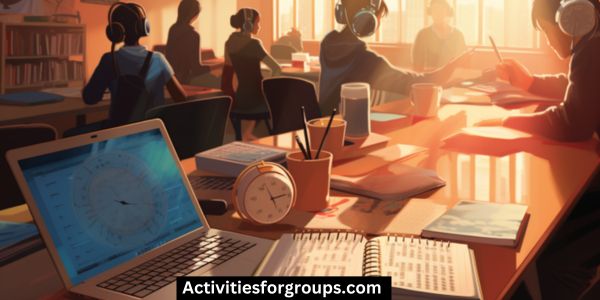Do you want to make your group study sessions more interactive and engaging? If so, you’re in the right place!

Here, you’ll learn how to:
- Establish ground rules
- Encourage participation
- Take breaks
- Incorporate fun activities
- Utilize technology
How to Make Group Study Sessions More Interactive and Engaging(Ideas and Examples)
Group study sessions can be an excellent way for students to deepen their understanding of course material, prepare for exams, and build collaborative skills. However, without the right structure and activities, these sessions can quickly become unproductive or monotonous. Here are some practical examples of how you can make your group study sessions more interactive, engaging, and fun.
Incorporate Technology:
- Quiz Apps: Use apps like Kahoot! or Quizizz to create custom quizzes that the group can take together. These platforms make learning fun and competitive.
- Study Apps: Leverage apps like Anki for flashcards or collaborative tools like Google Docs where everyone can contribute and edit study materials in real time.
Active Learning Techniques:
- Teach-Back Method: Have each member teach a concept to the group. This not only reinforces the material for the presenter but also helps clarify doubts within the group.
- Problem-Solving Sessions: Turn study sessions into problem-solving challenges where the group has to work together to solve complex questions or case studies.
Gamification:
- Rewards and Points: Assign points for correct answers or for contributing useful material. Offer small rewards for the top points earners to encourage participation.
- Role-Playing: For subjects like history or literature, role-play different historical figures or characters to discuss concepts or events.
Interactive Materials:
- Mind Maps: Create mind maps on a whiteboard or a large piece of paper to visualize connections between concepts.
- Flashcards: Use physical flashcards for quick-fire rounds of questions and answers, which can be a dynamic way of drilling key facts or formulas.
Discussion and Debate:
- Group Discussions: Choose a topic and have an open discussion. This encourages everyone to voice their opinions and learn through conversation.
- Debates: Split the group into two and have a structured debate on a controversial topic within the subject area.
Study Games:
- Jeopardy: Create a Jeopardy-style game with categories relevant to the subject matter. This encourages a competitive yet fun atmosphere.
- Pictionary: Draw concepts or terms and have the others guess what they represent. It’s a fun way to memorize and understand complex terms or processes.
Peer Review Sessions:
- Essay Swaps: Exchange essays or problem sets and provide each other with constructive feedback.
- Mock Exams: Write and exchange mock exam questions, then answer and discuss them as a group.
Social Learning:
- Study Circles: Break the group into smaller circles to discuss specific questions, then reconvene to share insights with the larger group.
- Pair Up: Pair off with a partner to quiz each other or explain difficult concepts.
Creative Breaks:
- Stretching or Exercise Breaks: Incorporate short physical activities to keep the energy levels high.
- Artistic Breaks: Use drawing or doodling related to the study material as a creative break to help retain information.
Real-World Connections:
- Field Trips: If possible, organize a visit to a museum, a historical site, or a company that is relevant to your study topic.
- Guest Speakers: Invite a speaker with professional experience in the subject area to provide practical insights and answer questions.
Remember, the key to an interactive and engaging group study session is variety and participation. Mix and match these strategies to keep your sessions dynamic and cater to different learning styles within the group. Not only will this make studying more enjoyable, but it will also help the information stick better and improve everyone’s performance. Happy studying!
General Tips to Make Group Study Sessions More Interactive and Engaging
With these simple tips, you’ll be able to create an enjoyable and productive learning environment for everyone.
Establish Ground Rules
You should establish ground rules for your group study sessions to ensure everyone gets the most out of the experience. This will help the group stay on track, keep everyone focused, and make sure everyone is respected.
Start by brainstorming a few ideas together to get the ball rolling. Everyone should have an equal opportunity to share their ideas. This is a great way to foster collaboration and encourage idea sharing.
Ground rules should also include guidelines for how to handle disagreements. This will help to protect everyone’s feelings and ensure that everyone is heard. It’s important to remember that everyone has different opinions and should be respected.
In addition, it’s important to set ground rules about using phones and other devices during the session. While it can be tempting to check your phone, it can be distracting to the group. Be sure to set clear expectations from the beginning and encourage everyone to respect each other’s time.
Encourage Participation
You can encourage participation in group study sessions by fostering a collaborative atmosphere. Here are three ways to do that:
- Start each session with icebreaker questions. This helps everyone to get to know one another better and creates a more comfortable environment for everyone to work together.
- Ask the group to brainstorm ideas for the study session. This encourages everyone to think of creative ways to approach the subject and can generate new and helpful insights.
- Make sure to give everyone a chance to speak. In larger groups, this may require assigning each person a specific topic to present on. This ensures that everyone has a chance to contribute and share their knowledge.
Take Breaks

You can also make group study sessions more interactive and engaging by taking regular breaks. Regularly taking breaks can help keep the energy level up in the group and give everyone time to digest the material that was discussed. Breaks can give everyone a chance to participate in open-ended questions, role playing, or other activities.
Short breaks throughout your study session can help make the process of learning and absorbing new information more effective. Research has shown that short breaks can help the brain retain information better than if the group had worked straight through. Taking breaks can also help people stay focused and engaged.
You can start by setting a timer for how long the break should last. Then, use the time to do an activity that gets everyone involved. Some ideas include talking about a news article, sharing a funny story, or playing a game. This could be a great time for the group to bond and get to know each other better.
If your group is working on a project, you can break it down into smaller tasks and take breaks in between each task. This can help the group stay focused and finish the project in a timely manner. The breaks can also be used to review any material that the group may have gone over.
Taking regular breaks throughout your group study session can make the process of learning more enjoyable. It can help keep the energy level high and give everyone a chance to participate in activities that will help them understand the material better. Breaks are also a great way to build relationships with the people in your study group.
Incorporate Fun Activities
By incorporating fun activities, you can make group study sessions more interactive and engaging. Role play scenarios and review games are two great activities that can keep everyone in the group engaged while still learning the material.
Here are 3 fun activities you can use to make studying more enjoyable:
- Role play scenarios – Have each group member act out a scene from the material being studied. This helps to bring the material to life and provides a more immersive and interactive experience.
- Review games – Using quiz-style games is a great way to review material and keep everyone motivated. It also helps to break up the monotony of simply reading through the material.
- Creativity challenges – Have each group member come up with a creative way to explain a concept from the material. This encourages everyone to think outside the box and can help to make the material more interesting and memorable.
Utilize Technology

How can you utilize technology to make group study sessions more interactive and engaging?
Technology has the potential to create a much more collaborative and stimulating learning environment for group study sessions.
Virtual brainstorming is a great way to get all the members of the group involved in the discussion and actively problem-solve together. You can use an online whiteboard to draw out ideas and take turns adding to the discussion.
Additionally, online quizzes are a fun way to review material and keep the group engaged. You can create or find online quizzes related to your topic of study and have the group answer the questions together to reinforce the material.
Frequently Asked Questions [FAQs]
How Do I Encourage Participation in a Group Study Session?
Encourage participation by brainstorming, role-playing, problem-solving, collaborating, debating, and making decisions together.
What Type of Activities Should I Incorporate for a More Interactive and Engaging Group Study Session?
Try incorporating activities like quiz games, brainstorming, role play, problem-solving, or debate sessions to make your group study sessions more interactive and engaging.
What Is the Best Way to Utilize Technology in Group Study Sessions?
You can use technology to make group study sessions more engaging by utilizing online quizzes or game apps. Try creating quizzes or playing game apps to keep everyone focused and help make studying more fun!
How Can I Ensure That Everyone Stays on Task During the Group Study Session?
You can foster accountability and brainstorm solutions by having each member take turns leading the discussion while the others stay on task.
What Are Some Creative Ways to Take Breaks During the Group Study Session?
Try brainstorming, problem-solving, mind mapping, and guessing games to break up the session and keep everyone engaged!
Conclusion
Group study sessions don’t have to be dull and unengaging. With a few simple steps, such as establishing ground rules, encouraging participation, taking breaks, incorporating fun activities, and utilizing technology, you can make your study sessions enjoyable and interactive.
By following these tips, your group can make the most of your study time and make it a more productive and enjoyable experience for everyone.




Leave a Reply